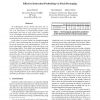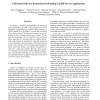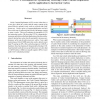EUROPAR
2005
Springer
14 years 5 months ago
2005
Springer
Instruction delivery is a critical component for wide-issue processors since its bandwidth and accuracy place an upper limit on performance. The processor front-end accuracy and ba...
IPPS
2005
IEEE
14 years 5 months ago
2005
IEEE
As technological process shrinks and clock rate increases, instruction caches can no longer be accessed in one cycle. Alternatives are implementing smaller caches (with higher mis...
GLVLSI
2005
IEEE
14 years 5 months ago
2005
IEEE
The instruction cache is a popular target for optimizations of microprocessor-based systems because of the cache’s high impact on system performance and power, and because of th...
ASPLOS
2006
ACM
14 years 5 months ago
2006
ACM
While hardware instruction caches are present in virtually all general-purpose and high-performance microprocessors today, many embedded processors use SRAM or scratchpad memories...
IEEEPACT
2007
IEEE
14 years 5 months ago
2007
IEEE
We present a detailed characterization of instruction cache performance for IBM’s J2EE-enabled web server, WebSphere Application Server (WAS). When running two J2EE benchmarks o...
GLVLSI
2008
IEEE
14 years 6 months ago
2008
IEEE
Share of leakage in cache memories is increasing with technology scaling. Studies show that most stored bits in instruction caches are zero, and hence, asymmetric SRAM cells which...
DATE
2008
IEEE
14 years 6 months ago
2008
IEEE
Cache-Content-Duplication (CCD) occurs when there is a miss for a block in a cache and the entire content of the missed block is already in the cache in a block with a different t...
ICCD
2001
IEEE
14 years 8 months ago
2001
IEEE
Filter cache has been proposed as an energy saving architectural feature [9]. A filter cache is placed between the CPU and the instruction cache (I-cache) to provide the instruct...
DAC
2009
ACM
15 years 16 days ago
2009
ACM
Energy consumption is of significant concern in battery operated embedded systems. In the processors of such systems, the instruction cache consumes a significant fraction of the ...



